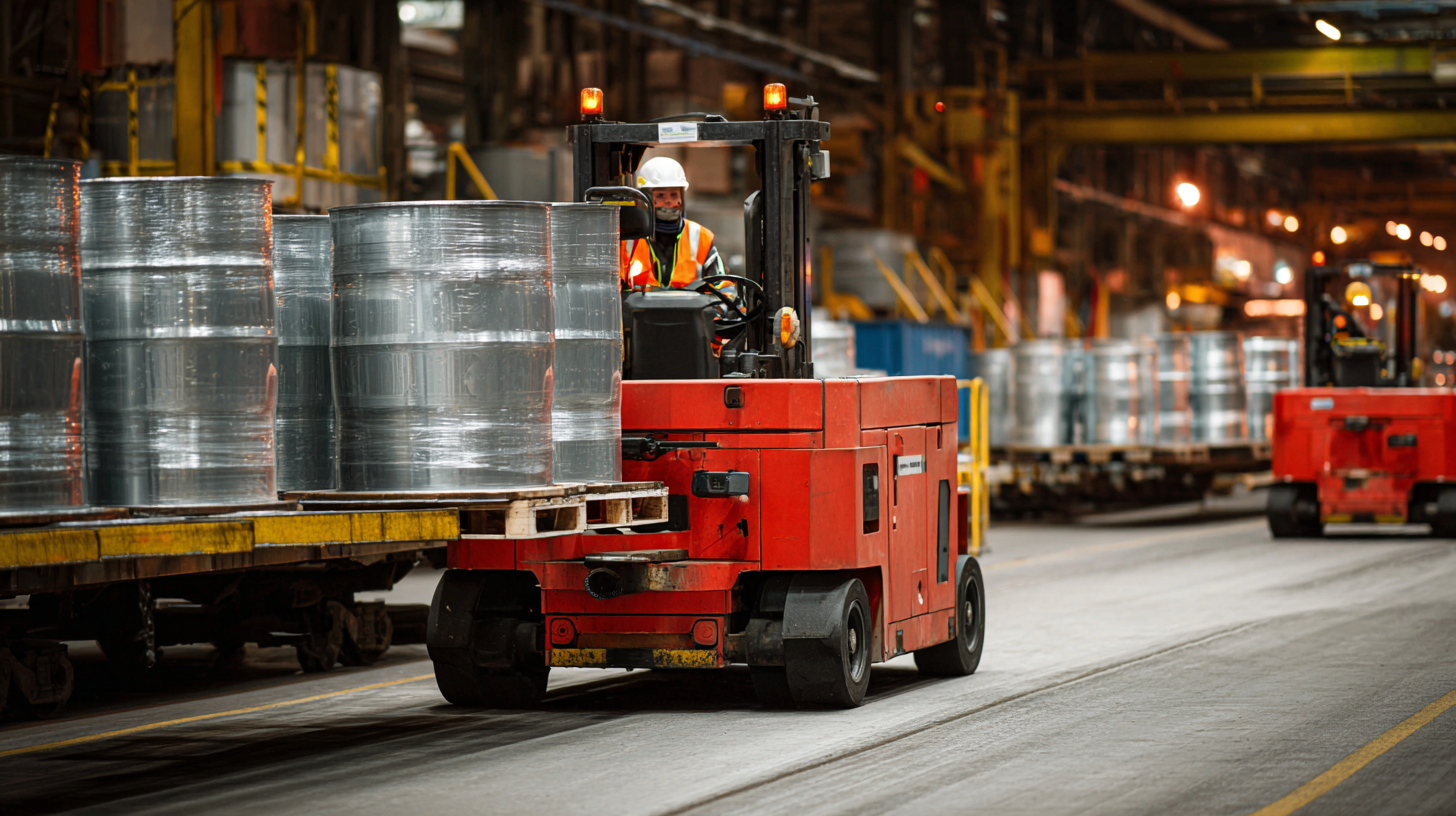Comparing Top Drum Lifters in the Market Analyzing Efficiency and Safety Features
In the industrial landscape, the efficiency of material handling equipment directly impacts productivity and safety, particularly when it comes to moving heavy drums. Drum Lifters, designed to facilitate the lifting and transporting of drums, have seen a surge in demand due to their crucial role in minimizing workplace injuries and streamlining operations. According to a report by the Material Handling Industry of America, adopting advanced lifting solutions can reduce manual handling incidents by up to 50%, emphasizing the importance of safety features in choosing the right equipment.

Furthermore, with ongoing innovations in design, modern Drum Lifters provide not only ergonomic benefits but also ensure lower maintenance costs compared to outdated models. This blog will delve into the top Drum Lifters currently available in the market, analyzing their efficiency and safety features while considering the advantages of after-sales services and repair expenses, ultimately guiding industries in selecting the optimal lifting solution for their needs.
Key Factors to Consider When Choosing a Drum Lifter for Your Needs
When selecting a drum lifter, several key factors come into play that can greatly influence your decision. First and foremost is the type of drum you intend to lift—whether it's a standard steel drum, a plastic model, or one with specific dimensions. This will determine the compatibility of the lifter with your equipment. Additionally, consider the weight capacity of the lifter. Ensure that it can handle the maximum weight of the drum you plan to lift, factoring in any liquid contents that might add significant weight.
Another crucial aspect is the safety features incorporated into the drum lifter design. Look for models that include stability systems or automatic locking mechanisms to prevent accidental drops. Ergonomic design is also essential; choose a lifter that facilitates easy handling and minimizes the risk of strain or injury to the operator.
**Tips:** Always evaluate the lift's ease of use in real-world scenarios, considering factors such as mobility and operational speed. It's beneficial to read user reviews and conduct a hands-on evaluation where possible. Furthermore, ensure that the drum lifter complies with industry safety standards, as this can significantly reduce risks in your workplace.
Comparing Top Drum Lifters in the Market
Comparative Analysis of Electric vs. Manual Drum Lifters in Efficiency
When comparing electric and manual drum lifters, efficiency and safety features become critical factors to consider. Electric drum lifters offer the advantage of reduced physical strain, allowing operators to lift heavy drums with minimal effort. This is particularly beneficial in high-demand environments where productivity is key. Additionally, they typically come equipped with built-in safety features, such as overload protection and automatic shut-off, ensuring safe operation under various conditions.
On the other hand, manual drum lifters can be more economical and easier to maintain, making them suitable for smaller operations or those with less frequent lifting needs. However, they require more physical effort and can be riskier if not used correctly. Operators must ensure proper training and awareness to prevent injuries.
**Tips**:
1. Evaluate your workload and choose the drum lifter that aligns with your operational needs to maximize efficiency.
2. Always prioritize safety by adhering to guidelines and utilizing personal protective equipment when operating manual lifters.
3. Consider maintenance and support options for electric models to ensure long-term reliability and performance.
Comparing Top Drum Lifters in the Market Analyzing Efficiency and Safety Features
| Type | Weight Capacity (lbs) | Lift Height (inches) | Power Source | Efficiency Rating | Safety Features |
|---|---|---|---|---|---|
| Electric | 800 | 48 | Electric | 95% | Emergency Stop, Overload Protection |
| Manual | 600 | 30 | Manual | 80% | Non-Slip Grip, Retractable Safety Guards |
| Electric | 1000 | 60 | Electric | 90% | Emergency Stop, Tilt Protection |
| Manual | 500 | 24 | Manual | 75% | Safety Lock, Sturdy Base |
Safety Features That Stand Out in Top Drum Lifters
 When it comes to selecting the right drum lifters, safety features should always be a top priority. Many of the leading drum lifters on the market today incorporate innovative technology to ensure operator safety. For instance, automatic shut-off mechanisms help prevent accidents when a drum is improperly loaded or if the lifter detects an imbalance. This feature not only minimizes the risk of personal injury but also protects the equipment from damage.
When it comes to selecting the right drum lifters, safety features should always be a top priority. Many of the leading drum lifters on the market today incorporate innovative technology to ensure operator safety. For instance, automatic shut-off mechanisms help prevent accidents when a drum is improperly loaded or if the lifter detects an imbalance. This feature not only minimizes the risk of personal injury but also protects the equipment from damage.
Another standout safety feature found in top drum lifters is the presence of ergonomic handle designs and non-slip grips. These elements reduce the strain on operators while ensuring a secure hold during operation. Additionally, models equipped with load indicators offer real-time feedback on the weight being lifted, alerting users to any potential overload situations. Such advancements not only enhance safety but also boost overall efficiency, allowing operators to work confidently and effectively in various environments.
Cost-Effectiveness of Alternative Drum Lifting Solutions
 When evaluating drum lifting solutions, it’s essential to consider not just the initial purchase price but also the long-term cost-effectiveness of various options available in the market. While traditional drum lifters might have lower upfront costs, they often lack the advanced safety features and efficiency boosts found in newer models. Investing in a drum lifter equipped with state-of-the-art safety mechanisms—for instance, automatic shut-off systems or improved load distribution—can significantly reduce workplace accidents and injuries, ultimately leading to lower insurance premiums and fewer lost workdays.
When evaluating drum lifting solutions, it’s essential to consider not just the initial purchase price but also the long-term cost-effectiveness of various options available in the market. While traditional drum lifters might have lower upfront costs, they often lack the advanced safety features and efficiency boosts found in newer models. Investing in a drum lifter equipped with state-of-the-art safety mechanisms—for instance, automatic shut-off systems or improved load distribution—can significantly reduce workplace accidents and injuries, ultimately leading to lower insurance premiums and fewer lost workdays.
Moreover, alternative drum lifting options such as manual lifts or drum rollers can provide a cost-effective solution for businesses with limited budgets. These tools, while generally simpler, can still achieve efficient results when used correctly. Over time, companies may find that these alternatives offer significant savings, not only in terms of equipment costs but also by reducing the need for extensive training or specialized personnel. By weighing the initial investment against the safety benefits and operational efficiency, businesses can make informed decisions that align with their financial and safety goals.
User Feedback: Real-World Experiences with Different Drum Lifters
In the realm of drum lifters, user feedback plays a crucial role in discerning the efficacy and safety of various products. Recent industry surveys indicate that over 75% of users prioritize safety features when selecting a drum lifter, highlighting the demand for equipment that not only improves productivity but also minimizes risk. Users frequently emphasize ease of operation and stability as key determinants of their satisfaction. Real-world feedback suggests that models equipped with hydraulic systems tend to outperform manual counterparts, offering enhanced lifting capabilities and reducing the physical strain on operators.
Moreover, the influence of personal experiences cannot be overstated. In interviews, many users have shared transformational stories about how effective drum lifters have impacted their workflow, contributing to significant time savings—reports indicate up to a 50% reduction in loading times with advanced models. This sentiment resonates across varying sectors, from manufacturing to pharmaceuticals, where efficiency directly correlates with operational success. As companies increasingly acknowledge the importance of user-centric design, they find themselves compelled to innovate, weaving safety and efficiency into the fabric of their product offerings.

